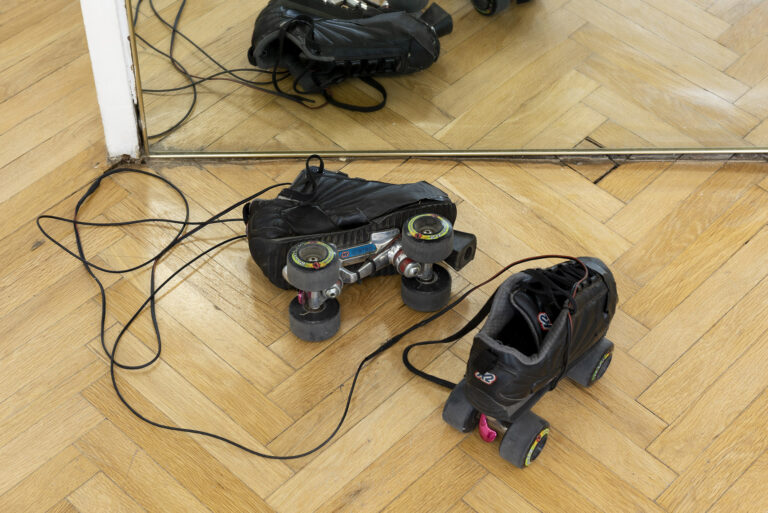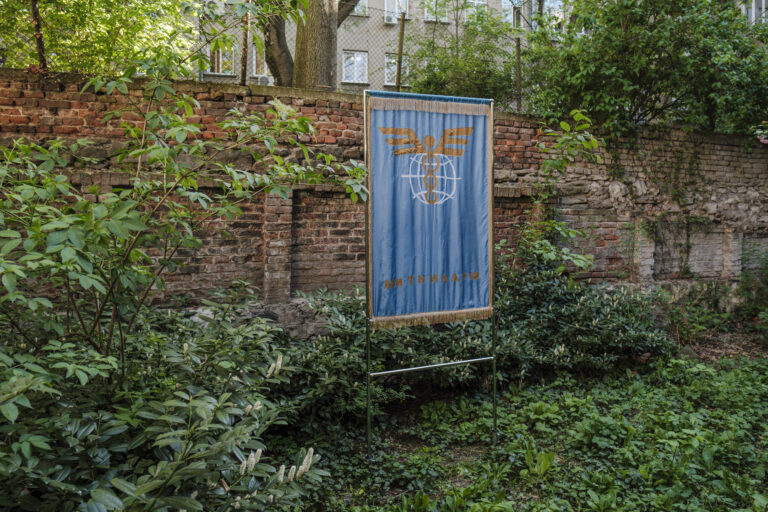Artists: Ina Valentinova, Yasen Vasilev, Lubomir Draganov, Stefan Ivanov, Maria Nalbantova, Martin Penev, Radostin Sedevchev, Miryana Todorova
Exhibition title: The Possible Institution
Curated by: Viktoria Draganova
Venue: Swimming Pool, Sofia, Bulgaria
Date: April 24 – June 13, 2021
Photography: courtesy and the artists and Swimming Pool, Sofia
The Possible Institution is a project about institutions – real, desired, past, internal, fantastic – and the possibilities within them. The project is designed as a process that began with a series of meetings with the participants Ina Valentinova, Yasen Vasilev, Lubomir Draganov, Stefan Ivanov, Maria Nalbantova, Martin Penev, Radostin Sedevchev, Miryana Todorova, Galena Sardamova, аnd Viktoria Draganova, and continues in the space of Swimming Pool as a public action accompanied by discussions, essays, and workshops.
The Possible Institution is part of a series of studies included in Swimming Pool’s programme which are devoted to the models of institutionality and processes of instituting today. More specifically, the objective of this project was to make sense of the relationship we have with various institutions as well as of the concepts we operate with, thereby also enabling us to identify new meanings and directions of instituting. Most of the participants invited to the project are artists and people close to the arts since we wanted to study the context of the cultural institution as such – the museum, academy, private art gallery, independent space, theatre, chitalishte (community cultural centre). That allowed us to respond to the problems in these traditional structures which seem to have been aggravated even further by the Covid-19 pandemic.
Institutions are at once norm and fiction. But this is only the beginning. During our conversations, the concept of “institution” revealed its many dimensions: the institution as geometry, psychology, metaphysics, history, infrastructure, activism, attitude, care. Viewed from the artist’s perspective, institutions looked like an organism constructed by the interaction of the architectures, beings, objects, ecologies, politics, feelings that are contained within their fabric. Questions arose about what lies at the beginning of an institution, how the personal and the collective are tied together, whether it’s at all possible for an institution to be just and fair. A number of needs appeared as well: the need for rethinking and the need for fantasizing, the need for sharing and the need for free action.
Actually, the possible institution is realized in the interconnected projects of the participants: in the space of Swimming Pool, Stefan Ivanov shares a sound story about different encounters with institutions – at home, in the street, at school, at university, in front of the TV and computer. Martin Penev collects piles of things we ignore, full of different-coloured animals – of the sort we encounter within ourselves and which lead to denial of opportunities, failure to follow our dreams – to the misplacement of things that could actually be useful. Maria Nalbantova examines the possibilities for taking a break from institutions and whether this break could ever be non-institutional. Radostin Sedevchev explores the paradox of Torricelli’s trumpet, looking for possibilities for constantly blending in and out, but also for the illusion of sinking into infinity. Lubomir Draganov takes part as the representative of a maybe-existing institute which has taken on the daunting task of shattering the fictional institutionalities we almost unintentionally build in our minds. Yasen Vasilev creates a musical score for an empty swimming pool, turning it into a laboratory for studying collective movement and restoring the sense of community. Through a series of livestreams and an installation, Miryana Todorova probes the relationship between personal desires and collective actions for change and more freedom. Ina Valentinova builds an educational programme around the projects of all participants, not only connecting them to the public and specific space but also reconsidering the mostly reductive educational programmes recently offered by museums and art galleries.
-Viktoria Draganova
Most of the projects can be seen at Swimming Pool while The Possible Institution is on; others exist as livestreamed interventions, online, or as workshops. The project also includes a series of impulse-talks with all the participants, as well as featured texts and essays by Ani Vaseva, Dessislava Dimova, Vladiya Mihaylova, and Viktoria Draganova.
The Possible Institution is realized with the support of the Visual Arts Programme of the Ministry of Culture. In 2021 the activity of Swimming Pool, represented by the Blue Cube Foundation, is supported by the National Culture Fund.
Installation view “The Possible Institution” at Swimming Pool, Sofia, 2021
Martin Penev, Piles of Things We Ignore, 2021. Installation, textiles, bamboo, variable size
Martin Penev, Piles of Things We Ignore, 2021. Installation, textiles, bamboo, variable size (detail)
Radostin Sedevchev, Torricelli’s Institution, 2021. Graph paper, pencil, acrylic paint on wall, variable size
Radostin Sedevchev, Torricelli’s Institution, 2021. Graph paper, pencil, acrylic paint on wall, variable size (detail)
Radostin Sedevchev, Torricelli’s Institution, 2021. Graph paper, pencil, acrylic paint on wall, variable size (detail)
Radostin Sedevchev, Torricelli’s Institution, 2021. Graph paper, pencil, acrylic paint on wall, variable size (detail)
Martin Penev, Piles of Things We Ignore, 2021. Installation, textiles, bamboo, variable size
Martin Penev, Piles of Things We Ignore, 2021. Installation, textiles, bamboo, variable size (detail)
Installation view “The Possible Institution” at Swimming Pool, Sofia, 2021
Installation view “The Possible Institution” at Swimming Pool, Sofia, 2021
Lubomir Draganov, Institute for Creating an Illusion of Existence of Possible Worlds as a Means for Turning Them Into Reality, 2021. Vinyl lettering, QR code for online access, 20 x 70 cm
Lubomir Draganov, Institute for Creating an Illusion of Existence of Possible Worlds as a Means for Turning Them Into Reality, 2021. Vinyl lettering, QR code for online access, 20 x 70 cm
Miryana Todorova, Between Gestures and Actions: From Desire to Revolution, 2020-2021. Installation/works on paper (color markers on paper)
Miryana Todorova, Between Gestures and Actions: From Desire to Revolution, 2020-2021. Installation/works on paper (color markers on paper) (detail)
Miryana Todorova, Between Gestures and Actions: From Desire to Revolution, 2020-2021. Installation/works on paper (color markers on paper) (detail)
Miryana Todorova, Between Gestures and Actions: From Desire to Revolution, 2020-2021. Installation/works on paper (color markers on paper) (detail)
Maria Nalbantova, Institutional Leisure, 2021. Artificial grass, wood
Maria Nalbantova, Institutional Leisure, 2021. Artificial grass, wood (detail)
Maria Nalbantova, Institutional Leisure, 2021. Artificial grass, wood (detail)
Maria Nalbantova, Institutional Leisure, 2021. Artificial grass, wood (detail)
Maria Nalbantova, Institutional Leisure, 2021. Artificial grass, wood (detail)
Maria Nalbantova, Institutional Leisure, 2021. Artificial grass, wood (detail)
Stefan Ivanov, Up and Down, 2021. Two audio players, two sets of headphones, two chairs, sound recording 24:04 min
Installation view “The Possible Institution” at Swimming Pool, Sofia, 2021
Ina Valentinova, From Still Life to …, 2021. Workshop
Ina Valentinova, From Still Life to …, 2021. Workshop
Miryana Todorova, Between Gestures and Actions: Fragmented Readings, 2021. Spontaneous performance/photo documentation
Miryana Todorova, Between Gestures and Actions: Fragmented Readings, 2021. Spontaneous performance/photo documentation
Miryana Todorova, Between Gestures and Actions: Fragmented Readings, 2021. Spontaneous performance/photo documentation




































